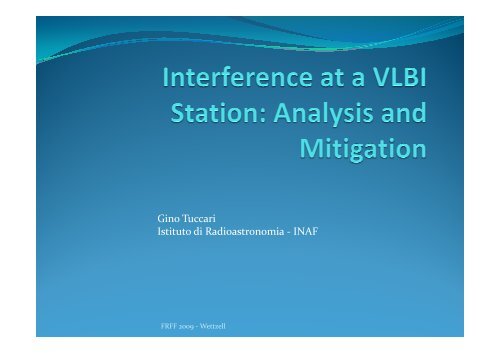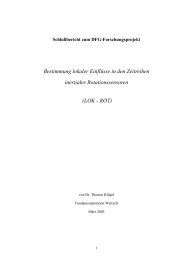Interference at a VLBI Station: Analysis and Mitigation
Interference at a VLBI Station: Analysis and Mitigation
Interference at a VLBI Station: Analysis and Mitigation
You also want an ePaper? Increase the reach of your titles
YUMPU automatically turns print PDFs into web optimized ePapers that Google loves.
Gino Tuccari<br />
Istituto di Radioastronomia - INAF<br />
FRFF 2009 - Wettzell
Items<br />
RFI: Wh<strong>at</strong> is <strong>and</strong> Where come from?<br />
How RFI affect observ<strong>at</strong>ions single-dish <strong>and</strong> <strong>VLBI</strong><br />
Example <strong>at</strong> a correl<strong>at</strong>or<br />
<strong>Analysis</strong> <strong>at</strong> a st<strong>at</strong>ion<br />
Front-end mitig<strong>at</strong>ion<br />
Back-end mitig<strong>at</strong>ion<br />
Conclusions<br />
FRFF 2009 - Wettzell
RFI<br />
For a radiotelescope is:<br />
any unwanted signal<br />
often with level > > cosmic sources<br />
produced by ground communic<strong>at</strong>ions<br />
produced by the radiotelescope equipment<br />
produced by space communic<strong>at</strong>ions<br />
FRFF 2009 - Wettzell
RFI (cont.)<br />
Alloc<strong>at</strong>ed b<strong>and</strong>s are very often too narrow for the wide<br />
b<strong>and</strong> required to achieve high sensitivity<br />
Spectral line sometimes not in the protected b<strong>and</strong><br />
Radio astronomy <strong>and</strong> geodesy then must observe<br />
b<strong>and</strong>s alloc<strong>at</strong>ed for other services<br />
Radiotelescopes need to find str<strong>at</strong>egies <strong>and</strong> methods<br />
to minimize error effects on useful d<strong>at</strong>a<br />
FRFF 2009 - Wettzell
How RFI affect observ<strong>at</strong>ions (cont.)<br />
Sensitivity of a radiotelescope + receiver is set by the<br />
system noise temper<strong>at</strong>ure => tolerance to RFI needs to<br />
be compared to this<br />
Probability to have RFI in the main beam is low, but<br />
still possible<br />
In normal condition RFI enter the system trough the<br />
side lobes<br />
An easy approxim<strong>at</strong>ion for most of the cases is th<strong>at</strong> we<br />
dispose of an additional 0 dBi antenna with collecting<br />
area λ 2 / 4 π<br />
FRFF 2009 - Wettzell
How RFI affect observ<strong>at</strong>ions (cont.)<br />
RFI to noise power<br />
r<strong>at</strong>io is then<br />
In single-dish observ<strong>at</strong>ions with integr<strong>at</strong>ion time t such value is<br />
multiplied by <strong>and</strong> represents the most sensitive observing mode to<br />
RFI.<br />
Harmful thresholds in the RFI flux density can be defined for typical<br />
observing conditions. For instance toler<strong>at</strong>ing a 10% RFI level with respect<br />
to the system noise produces thresholds of<br />
-170 dBm/m 2 @ 100MHz, -160 dBm/m 2 @ 1GHz,<br />
-130 dBm/m 2 @ 10GHz, -100 dBm/m 2 @ 100GHz<br />
FRFF 2009 - Wettzell
How RFI affect observ<strong>at</strong>ions (cont.)<br />
In <strong>VLBI</strong> RFI introduce additional uncorrel<strong>at</strong>ed noise so the<br />
correl<strong>at</strong>ion coefficient is modified like<br />
RFI in practice increase the system temper<strong>at</strong>ure in one or<br />
both st<strong>at</strong>ions reducing the sensitivity<br />
Typically the harmful level in <strong>VLBI</strong> is about 40 dB gre<strong>at</strong>er<br />
than the single-dish case toler<strong>at</strong>ing a 1 % interference to<br />
system noise r<strong>at</strong>io<br />
FRFF 2009 - Wettzell
Example <strong>at</strong> the correl<strong>at</strong>or<br />
FRFF 2009 - Wettzell
Example <strong>at</strong> the correl<strong>at</strong>or<br />
FRFF 2009 - Wettzell
FRFF 2009 - Wettzell
Control room<br />
At a <strong>VLBI</strong> st<strong>at</strong>ion<br />
FRFF 2009 - Wettzell
At a <strong>VLBI</strong> st<strong>at</strong>ion<br />
If we need to fight against an enemy it’s better we<br />
know who is <strong>and</strong> where is coming from<br />
Any st<strong>at</strong>ion should have personnel dedic<strong>at</strong>ed part of<br />
the time to have knowledge of RFI<br />
A system<strong>at</strong>ic <strong>and</strong> autom<strong>at</strong>ic monitoring could be<br />
worth to be set<br />
A list with the RFI inform<strong>at</strong>ion of frequency,<br />
polariz<strong>at</strong>ion, direction, bwd, time presence, etc.<br />
represents a sort of RFI_ID_card<br />
St<strong>and</strong>ardiz<strong>at</strong>ion could be worth<br />
FRFF 2009 - Wettzell
Example of equipment to monitor RFI<br />
FRFF 2009 - Wettzell
How to monitor<br />
FRFF 2009 - Wettzell
When to monitor<br />
FRFF 2009 - Wettzell
Wh<strong>at</strong> to monitor<br />
FRFF 2009 - Wettzell
Example of log file<br />
FRFF 2009 - Wettzell
Very strong interference<br />
For worst case RFI able to s<strong>at</strong>ur<strong>at</strong>e (or distroy) the<br />
front-end LNA some pre-filtering would be required<br />
Hight Temper<strong>at</strong>ure Superconducting (HTS) m<strong>at</strong>erials<br />
could offer a solution<br />
Different possibilities, one explored: YBCO on LaAlO3<br />
substr<strong>at</strong>e<br />
In Noto extensively studied <strong>and</strong> simul<strong>at</strong>ed X, C <strong>and</strong> L<br />
L b<strong>and</strong> filter realised in Noto to reduce a strong radar<br />
emission<br />
Other examples (few) are in liter<strong>at</strong>ure<br />
FRFF 2009 - Wettzell
Noto L b<strong>and</strong> HST Filter<br />
FRFF 2009 - Wettzell
Noto L b<strong>and</strong> HST Filter<br />
FRFF 2009 - Wettzell
Other examples<br />
FRFF 2009 - Wettzell
Other examples (cont.)<br />
FRFF 2009 - Wettzell
Relevant RFI: mitig<strong>at</strong>ion in digital<br />
domain<br />
Can be removed <strong>at</strong> different stages in the digital<br />
process<br />
Time – Frequency – Time domain conversion <strong>and</strong><br />
clipping have been extensively simul<strong>at</strong>ed <strong>and</strong> tested <strong>at</strong><br />
pre-conversion stages in the DBBC (simple)<br />
More complex oper<strong>at</strong>ions can be realized based on<br />
real-time cancelling (complex but possible, see several<br />
examples in liter<strong>at</strong>ure, eg. Westerbork)<br />
FRFF 2009 - Wettzell
Method adopted in the DBBC<br />
An additional Core2 is required as front-end element<br />
for 2 polariz<strong>at</strong>ions<br />
ADB1/2<br />
ADB1/2<br />
FFT -1<br />
FFT -1<br />
Total Power<br />
RFI Mask<br />
FRFF 2009 - Wettzell<br />
Core2<br />
Threshold<br />
Threshold<br />
FFT<br />
FFT
Conclusions for <strong>VLBI</strong>2010<br />
It looks reasonable to evalu<strong>at</strong>e whether a st<strong>at</strong>ion should<br />
dispose of RFI monitor equipment<br />
It could be worth to evalu<strong>at</strong>e if a st<strong>and</strong>ardized method is<br />
useful<br />
A real-time RFI log file to be added to other observ<strong>at</strong>ion<br />
logs?<br />
With a continuous receiving b<strong>and</strong> a tuning str<strong>at</strong>egy to<br />
avoid RFI is possible<br />
Worst case signals (s<strong>at</strong>ur<strong>at</strong>ion) needs to be tre<strong>at</strong>ed case by<br />
case<br />
Mitig<strong>at</strong>ion to reduce large peaks in the b<strong>and</strong> is possible<br />
with digital methods before b<strong>and</strong> conversion<br />
FRFF 2009 - Wettzell










